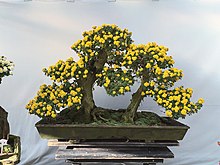| This article uses bare URLs, which are uninformative and vulnerable to link rot. Please consider converting them to full citations to ensure the article remains verifiable and maintains a consistent citation style. Several templates and tools are available to assist in formatting, such as reFill (documentation) and Citation bot (documentation). (August 2022) (Learn how and when to remove this message) |

Chrysanthemum bonsai (Japanese: 菊の盆栽, romanized: Kiku no bonsai, lit. 'Chrysanthemum tray planting', pronunciation) is a Japanese art form using cultivation techniques to produce, in containers, chrysanthemum flowers that mimic the shape and scale of full size trees, called bonsai.
Cultivation and care
Bonsai cultivation and care requires techniques and tools that are specialized to support the growth and maintenance of the flowers in small containers. There are several cultivated varieties of chrysanthemum that possess the ability to be trained into many of the traditional bonsai styles associated with woody trunked trees and shrubs. But since chrysanthemum rarely grow to be old enough to have wood, deadwood bonsai techniques may also be used.
Chrysanthemums are perennials, and while it is possible to keep a chrysanthemum bonsai alive for a number of years (old wood), it is more likely that the bonsai will be 'finished' after all the blooms have faded.
The chrysanthemum bonsai artist must complete all design work in fewer than ten months. Most chrysanthemum bonsai artists in the northern latitudes of the United States start the training of their bonsai in April, and are finished by the middle of September.
Traditionally in Japan the Chrysanthemum exhibitions showcase the different bonsai forms. This takes place in autumn around the months of October and November.
Styles
Various bonsai styles exist, such as the cascade style, the clinging to a rock style, and the forest style.
See also
References
- https://www.jataff.jp/kiku/kiku04-3.htm
- ^ "Chrysanthemum bonsai article by Dale Cochoy". BonsaiMary. Retrieved 30 October 2019.
- "Chrysanthemum bonsai". BonsaiMary. Retrieved 30 October 2019.
- "新宿御苑の菊花壇情報". fng.or.jp. Archived from the original on 9 March 2016. Retrieved 30 October 2019.
- "Chrysanthemum bonsai article by John Capobianco". BonsaiMary. Retrieved 30 October 2019.
Bibliography
- Tameji Nakajima, H. Carl Young. The art of the chrysanthemum: Japanese techniques for creating bonsai, cascades, giants and other potted styles. Harper & Row (1965)
External links
![]() Media related to Chrysanthemum bonsai at Wikimedia Commons
Media related to Chrysanthemum bonsai at Wikimedia Commons
- 日本の伝統文化・菊の盆栽Traditional culture of Japan "bonsai of chrysanthemum"
- Tiny Flowers, Big Hit: Chrysanthemum Bonsai | Longwood Gardens
This article related to the culture of Japan is a stub. You can help Misplaced Pages by expanding it. |
This botany article is a stub. You can help Misplaced Pages by expanding it. |



